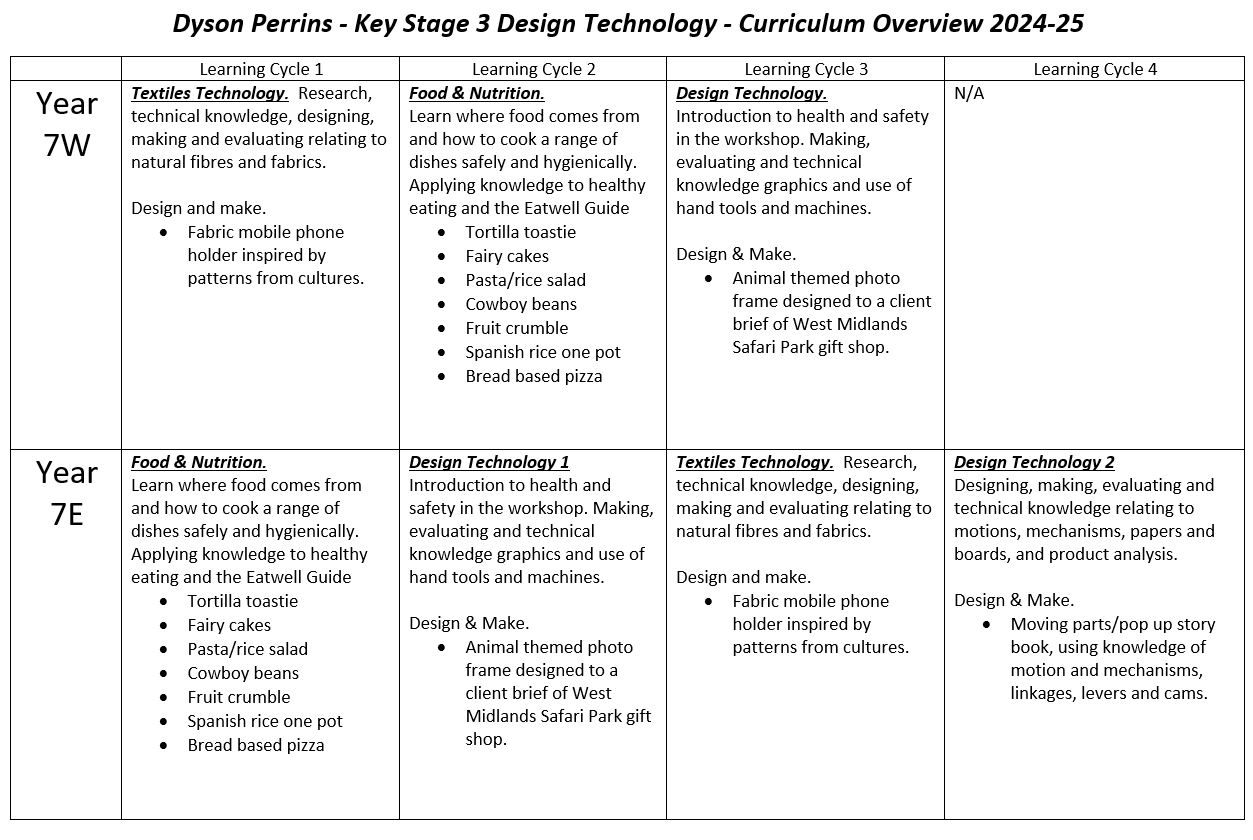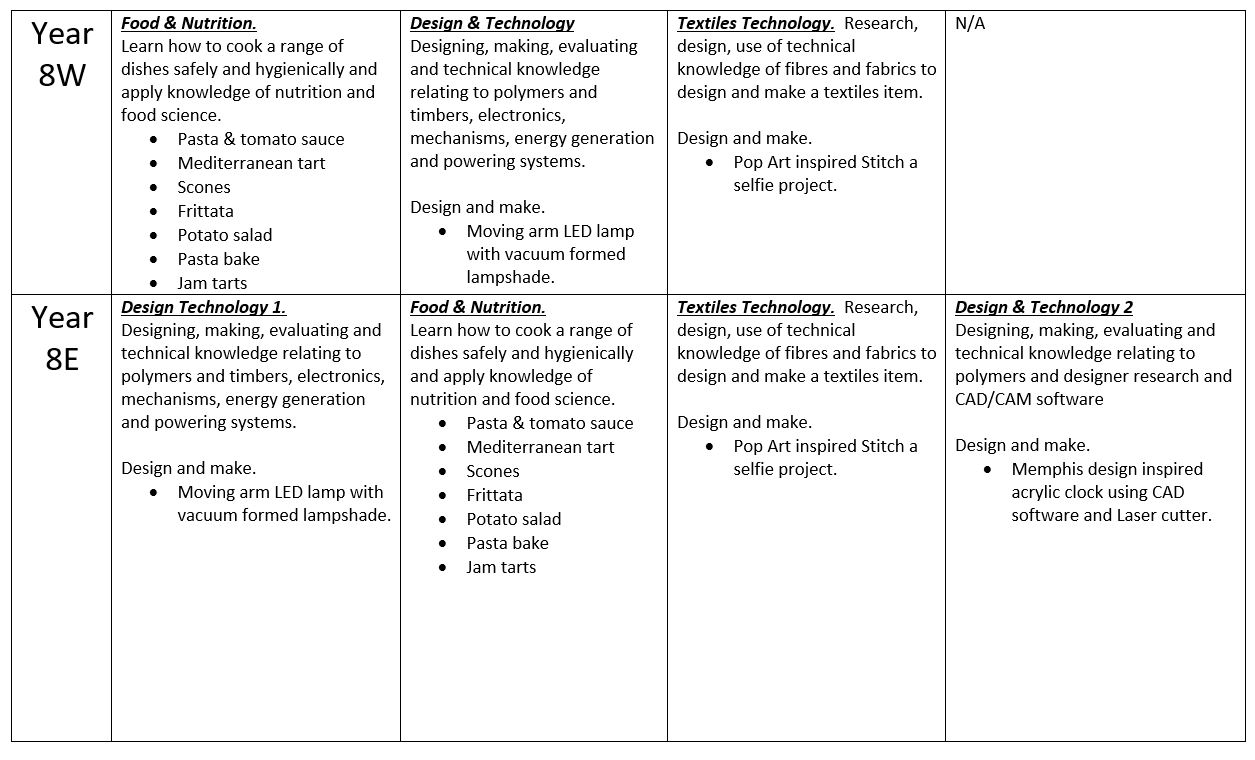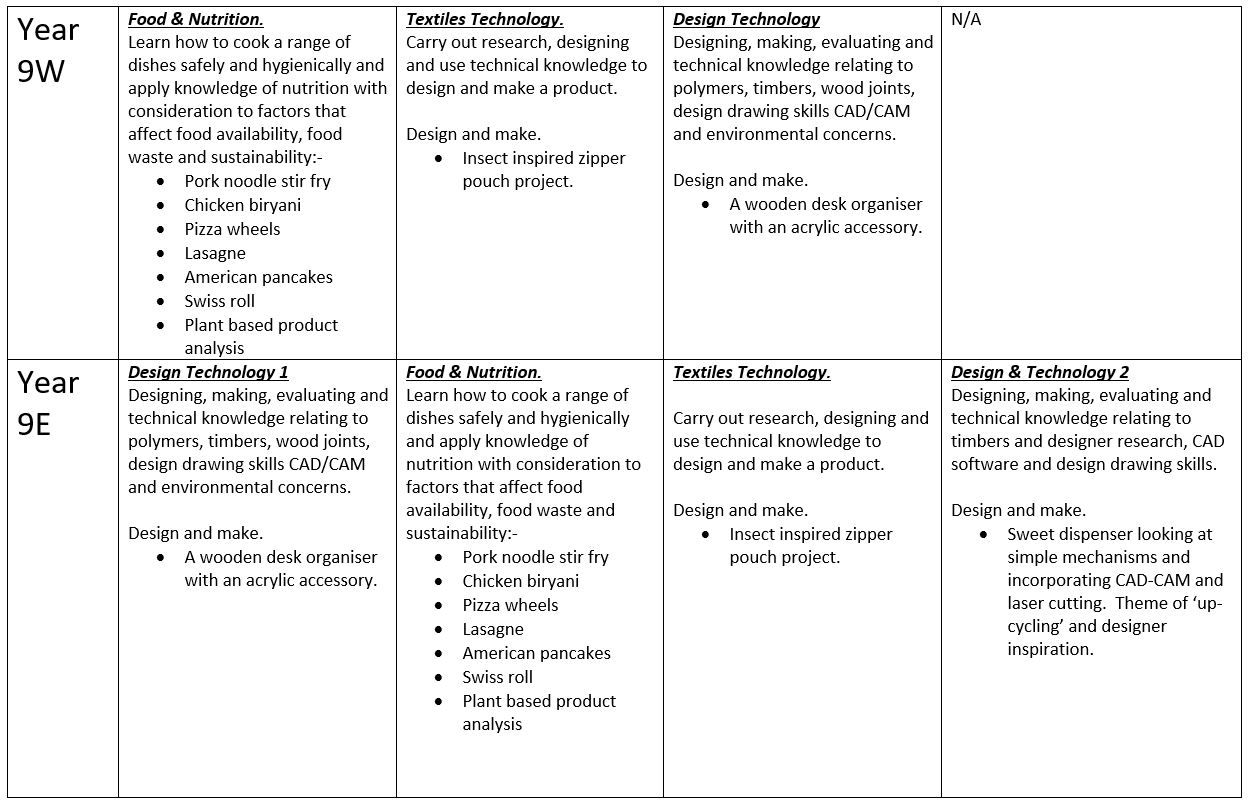|
Edexcel GCSE Design & Technology
https://qualifications.pearson.com/en/qualifications/edexcel-gcses/design-and-technology-2017.html
DT develops student’s confidence when working with materials such as wood and plastic. DT is both a practical and theory based subject with 50% exam and 50% coursework project. Students are encouraged to combine designing and making skills with knowledge and understanding of materials in order to make quality products. What makes this course really enjoyable is that you will learn how to do things through practical experience.
Year is mostly learning the exam theory with practical based projects to help reinforce learning. In year 11 student’s work on their NEA coursework project whilst revising the exam theory. The coursework consists of an online portfolio of research and design work before commencing with the practical. The final term of Y11 is spent preparing for the written examination. DT provides excellent preparation for further studies such as A level Product Design, Apprenticeships and ultimately employment such as a career in engineering and construction.
|
|
Learning Cycle 1
|
Learning Cycle 2
|
Learning Cycle 3
|
|
Year 10
|
For this learning cycle students cover the Timber section of the theory, learning about:
Sources of timber and the categorisation of the types, properties and structure of natural and manufactured timbers. Typical stock forms, types and sizes. The way in which the selection of each natural and manufactured timber is influenced. Environmental impacts.
Strengthening timber, joints techniques, tools, equipment and processes. Surface treatments and finishes and scales of production.
Alongside this theory students manufacture a toolbox, using knowledge of wood joints, a range of tools and equipment’s and appropriate finishing techniques.
|
For this learning cycle students cover the core theory needed for the exam.
This includes:
The impact of new and emerging technologies. Thermoforming and thermosetting polymers, natural, synthetic, blended and mixed fibres, and woven, non-woven and knitted textiles, papers and boards, ferrous and non-ferrous metals. The functions of mechanical devices used to produce different sorts of movements.
How energy is generated and stored in order to choose and use appropriate sources to make products and power systems
Developments in modern and smart materials, composite materials and technical textiles
Alongside this theory pupils make resin keyrings, felt coaster and moving part cam toys with a mixture of timber and polymer materials.
|
For the first half term we complete the core theory, including:
How electronic systems provide functionality to products and processes. The use of programmable components to embed functionality into products. Environmental, social and economic challenges.
Investigate and analyse the work of past and present professionals and companies in order to inform design
June 01st Contextual challenges released by exam board and coursework begins
|
|
Year 11
|
Working on NEA coursework portfolio with revision tasks and homework.
Section 1 - Investigation
- This includes investigating design possibilities through research involving a user/client, the identification of a suitable design brief, and writing of a specification.
Section 2 - Design
- This includes producing different design ideas, reviewing these ideas against the specification and with a user/client, refining and developing a chosen design, the review of the chosen design, and the communication of design ideas through written, CAD and graphical methods
|
Working on NEA coursework portfolio with revision tasks and homework.
Section 3 – Manufacture
- This includes selecting appropriate materials and component parts, the manufacture of the solution evidencing skills and processes, and a focus on quality and accuracy.
Section 4 – Evaluate
- This includes testing of the made solution against measurable and technical criteria from the specification, and reflective analysis and evaluation, including a life cycle analysis (LCA).
|
Complete all controlled assessment.
Revision as a class and exam preparation.
|
BTEC Tech Award in Art and Design Practice (2022) specialising in Fashion and Textiles
https://qualifications.pearson.com/en/qualifications/btec-tech-awards/art-and-design-practice-2022.html
What does the qualification cover?
This qualification will offer pupils the opportunity to build the range of knowledge, understanding and practical skills they need to progress to further learning, and will also give them an engaging and stimulating introduction to the world of Textiles. They will explore some of the key areas within the creative sector, learning how to address the needs of clients and create textiles work that meets creative project briefs.
Everyone taking this qualification will study two components, covering the following content areas:
- Component 1: Creative Practice in Art and Design - investigating textiles practice to inform generation and communication of ideas and developing practical skills through exploration of specialist materials, techniques and processes.
- Component 2: Responding to a Brief - applying textiles skills and techniques to develop a response to a brief.
|
|
Learning Cycle 1
|
Learning Cycle 2
|
Learning Cycle 3
|
|
Year 10
|
The first term is aimed at developing pupils’ skills, knowledge and confidence by practicing all the techniques and tasks involved in a coursework project. Pupils will start with 6 weeks of surface decoration textiles techniques workshops producing a wide range of fabric samples. They will then learn how to undertake thorough investigations into a theme as well as the work of Artists and Designers. The results of this research informs their own designs and final piece for this project.
|
Component 1: Creative Practice in Art and Design. This is a set assignment by Pearson which has a vocational context and theme.
Pupils will produce this coursework project demonstrating all the skills they learnt in term 1. The project has an allocated time of 20 hours and is divided into 4 timed tasks.
|
Continue with Component 1 until May.
This project is marked internally.
The Summer term will focus on further developing surface decoration and construction skills.
|
|
Year 11
|
This term will be spent developing and broadening pupils’ skills and knowledge further to prepare them for Component 2 (exam project) they will start in January. They will produce a practice project.
|
Component 2: Responding to a client brief. This is a set assignment by Pearson.
The project has an allocated time of 20 hours and is divided into 4 timed tasks which are different to Component 1.
Pupils will have 2 school days off timetable to complete their 8 hour final piece in exam conditions. They also have to create a digital portfolio. This project is assessed by the exam board.
|
This course is complete by May.
Lessons will then be spent revising for other subjects.
|
AQA Food Preparation and Nutrition
https://www.aqa.org.uk/subjects/food/gcse/food-preparation-and-nutrition-8585
You will be taught the science behind what makes food tasty in a new GCSE called Food Preparation and Nutrition from exam board AQA
This qualification will equip you with:-
- an exceptional range of kitchen skills
- an in-depth understanding of nutrition
At the heart of the qualification is a focus on developing practical cookery skills and a strong understanding of nutrition
Assessment:
50% Exam – split into 2 sections
50% Coursework or NEA – split into 2 parts
- Food Investigation (15%) - Sept 1st in Y11
Based on food science e.g. investigate the best flour to make bread
Recommended time: 10 hours
- Food Preparation Assessment (35%) - Nov 1st in Y11
Students will plan, prepare, cook and present a three course menu within 3 hours
Recommended time: 20 hours (inclusive of 3 hour practical period)
To also include a concise portfolio that:
|
|
Learning Cycle 1
|
Learning Cycle 2
|
Learning Cycle 3
|
|
Year 10
|
Food safety; food spoilage and contamination and the principles of food safety
Food, Nutrition and Health; macronutrients and micronutrients
|
Food, Nutrition and Health; nutritional needs and health
Food Provenance; environmental impact and sustainability of food, food production and processing
|
Food Science; cooking of food and heat transfer, functional and chemical properties of food
|
|
Year 11
|
NEA1 Food Investigation; based on food science 15% of GCSE
Food Choice; factors affecting food choice, British and international cuisine, sensory evaluation, food labelling and marketing
|
Food Choice; factors affecting food choice, British and international cuisine, sensory evaluation, food labelling and marketing
NEA 2 Food Preparation Assessment; based on food preparation and nutrition 35% of GCSE
|
NEA 2 Food Preparation Assessment
Revision for written paper
|
OCR Cambridge National Child Development
Key Stage 4 course:
OCR Cambridge National Child Development Level 1/Level 2
https://ocr.org.uk/qualifications/cambridge-nationals/child-development-level-1-2-j809/
The Cambridge National in Child Development covers all aspects of child development and parental responsibility from conception to five years. Students develop the essential theoretical knowledge and practical skills needed to create the best conditions for a child’s development and well-being.
The course is composed of 3 units:
RO57: Health & well-being for child development is an external exam sat in June in Year 11.
RO58: Create a safe environment and understand the nutritional needs of children from birth to five years. This is a piece of controlled assessment about choosing equipment for a nursery and designing the layout of a nursery. Students will also research the nutritional needs of children.
RO59: Understand the development of a child from one to five years. This is the second piece of controlled assessment researching the benefits of play and then planning and carrying out activities with a chosen child.
Current Year 10’s 2024-2026
|
|
Learning Cycle 1
|
Learning Cycle 2
|
Learning Cycle 3
|
|
Year 10
|
RO57: Topic 1: Pre conception health and reproduction
RO57: Topic 2: Antenatal care and preparation for birth
RO58: Topic 1 – Creating a safe environment in a childcare setting. 1.1 Plan to create a safe environment in a childcare setting.
RO58: Topic 2 – Choosing suitable equipment for a childcare setting. Essential equipment and factors for choice.
|
RO58: Topic 2 – Choosing suitable equipment for a childcare setting. Essential equipment and factors for choice.
R058: Topic 3 & 4 – Nutritional needs of children from birth to five years. Current Government dietary recommendations for healthy eating for children from birth to five years
|
Submission of coursework in May.
RO57: Topic 3: Postnatal checks, postnatal care and the conditions for development
RO57: Topic 4: Childhood illnesses and a child safe environment
|
|
Year 11
|
Start RO59 Coursework
- Physical, intellectual and social development norms from one to five years.
- Stages and types of play and how play benefits development
- Observation and recording methods
- Plan and evaluate play activities suitable for child aged 1-5 years.
|
Complete RO59. Deadline January.
Revision of RO57 all four topics.
|
Those who need to resubmit RO58 will submit their coursework in May.
Revision for RO57.
|
Current Year 11’s 2023-2025
|
|
Learning Cycle 1
|
Learning Cycle 2
|
Learning Cycle 3
|
|
Year 10
|
RO57: Topic 1: Pre-conception health and reproduction
RO57: Topic 2: Antenatal care and preparation for birth
Start RO59 Coursework
- Physical, intellectual and social development norms from one to five years.
- Stages and types of play and how play benefits development
|
RO59:
- Observation and recording methods
- Plan and evaluate play activities suitable for child aged 1-5 years.
|
Coursework submission in May.
RO57: Topic 3: Postnatal checks, postnatal care and the conditions for development
RO57: Topic 4: Childhood illnesses and a child safe environment
|
|
Year 11
|
RO58: Topic 1 – Creating a safe environment in a childcare setting. Plan to create a safe environment in a childcare setting.
RO58: Topic 2 – Choosing suitable equipment for a childcare setting. Essential equipment and factors for choice.
RO58: Topic 2 – Choosing suitable equipment for a childcare setting. Essential equipment and factors for choice.
R058: Topic 3 & 4 – Nutritional needs of children from birth to five years. Current Government dietary recommendations for healthy eating for children from birth to five years
Start RO59 Coursework
- Physical, intellectual and social development norms from one to five years.
- Stages and types of play and how play benefits development
- Observation and recording methods
- Plan and evaluate play activities suitable for child aged 1-5 years.
|
Complete RO58. Internal deadline January.
Start RO59 Coursework
- Physical, intellectual and social development norms from one to five years.
- Stages and types of play and how play benefits development
- Observation and recording methods
- Plan and evaluate play activities suitable for child aged 1-5 years.
Revision of RO57 all four topics.
|
Those who need to resubmit coursework RO59 submit their coursework in May.
Revision for RO57.
|
|





